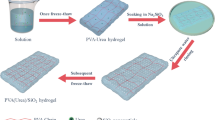Abstract
The aim of this work was to use sol–gel processing to develop bioactive materials to serve as scaffolds for tissue engineering that will allow the incorporation and release of proteins to stimulate cell function and tissue growth. We obtained organofunctionalized silica with large content of amine and mercaptan groups (up to 25%). The developed method can allow the incorporation and delivery of proteins at a controlled rate. We also produced bioactive foams with binary SiO2–CaO and ternary SiO2–CaO–P2O5 compositions. In order to enhance peptide–material surface properties, the bioactive foams were modified with amine and mercaptan groups. These materials exhibit a highly interconnected macroporous network and high surface area. These textural features together with the incorporation of organic functionally groups may enable them to be used as scaffolds for the engineering of soft tissue.
Similar content being viewed by others
References
Y. Senuma, S. Franceschin and J. G. Hilborn, Biomaterials 21 (2000) 1135.
M. H. Sheridan, L. D. Shea, M. C. Peters and D. J. Mooney, J. Control. Rel. 64 (2000) 91.
L. L. Hench, D. L. Wheeler and D. C. Greenspan, J. Sol-Gel Sci. Technol. 13 (1998) 245.
P. Ducheyne and Q. Qiu, Biomaterials 20 (1999) 2287.
B. K. Mann, A. T. Tsai, T. Scott-Burden and J. L. West, ibid. 20 (1999) 2281.
H. S. Mansur, W. L. Vasconcelos, R. F. S. Lenza, R. L. OrÉfice, E. F. Reis and Z. P. Lobato, J. Non-Cryst. Solids 273 (2000) 109.
J. Parrado, F. Millan and J. Bautista, Process Biochem. 30 (1995) 735.
S. B. Nicoll, S. Radin, E. M. Santos, R. S. Tuan and P. Ducheyne, Biomaterials 18 (1997) 853.
H. S. Mansur, R. L. OrÉfice, W. L. Vasconcelos, R. F. S. Lenza and Z. P. Lobato, J. Int. Feder. Med. Biol. Eng. 37 (1999) 372.
P. Sepulveda, J. Am. Cer. Soc. Bull. 76 (1997) 61.
R. F. S. Lenza and W. L. Vasconcelos, J. Non-Cryst. Solids 273 (2000) 164.
P. Sepulveda, J. R. Jones and L. L. Hench, J. Biomed. Mater. Res. (In press).
P. Saravanapavan and L. L. Hench, J. Biomed. Mater. Res. 54 (2001) 608.
M. M. Pereira, A. E. Clark and L. L. Hench, J. Mater. Synt. Process 2 (1994) 189.
Quantachrome Catalog-Autosorb 1, 12/97.
S. Brunauer, I. S. Deming, W. S. Deming and E. Teller, J. Amer. Chem. Soc. 62 (1940) 1723.
C. J. Brinker and G. W. Scherer, in “Sol-Gel Science: The Physics and Chemistry of Sol-Gel Processing” (Academic Press, San Diego, 1990) p. 907.
N. K. Raman, T. L. Ward, C. J. Brinker, R. Sehgal, D. M. Smith, Z. Duan and M. Hampden-Smith, Appl. Catal. A General 69 (1993) 65.
K. Kuraoka, Y. Chujo and T. Yazawa, J. Memb. Sci. 182 (2001) 139.
A. B. Jedlicka and A. G. Clare, J. Non-Cryst. Solids 28 (2001) 6.
D. M. Liu and I. W. Chen, Acta Mater. 18 (1999) 4535.
S. Joschek, B. Nies, R. Krotz and A. Gopferich, Biomaterials 21 (2000) 1645.
Author information
Authors and Affiliations
Corresponding author
Rights and permissions
About this article
Cite this article
Lenza, R.F.S., Vasconcelos, W.L., Jones, J.R. et al. Surface-modified 3D scaffolds for tissue engineering. Journal of Materials Science: Materials in Medicine 13, 837–842 (2002). https://doi.org/10.1023/A:1016592127407
Issue Date:
DOI: https://doi.org/10.1023/A:1016592127407




